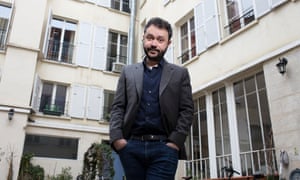
N
ot so long ago, the French cartoonist Riad Sattouf was signing books at a Paris librairie. At this kind of event, his habit is always to ask those who come up to meet him what they do for a living, and so it was that on this day a young woman replied to his regular question with the words: “I’m a geopolitical analyst specialising in the Middle East at the Quai d’Orsay [the French ministry of foreign affairs].” Suddenly, Sattouf was all ears. Here was someone he could really use. “Everyone is always asking me what is going to happen in Syria,” he told her, mock plaintively. “So, please, tell me what people are saying in your high-class political circles.” The woman’s answer was brief, to the point. “We are looking at decades of chaos,” she said.
In the small wood-panelled restaurant where we’re having lunch, Sattouf hoots with laughter, as if to say: “If this is the best they can do at the Quai d’Orsay, what hope do I have?” But his guffawing is forced, deliberately tinny. As he well knows, the facts about Syria, such as they are, are neither here nor there; even had this woman been able to give him some clue as to the country’s future, he would still be reluctant to discuss it in public himself. Like most cartoonists inFrance, he remains “traumatised” by the events of January 2015, when two jihadists stormed the offices of the satirical magazine Charlie Hebdo, killing 12 people.
“Cartoonists are nerds,” he says, hunching awkwardly over his plate, pretending for a moment that his knife is a pen. “We’re men with no girlfriends who spend the whole day drawing, and then, suddenly, we’re made to feel as if we’re responsible for all the wars of the world.” In his case, though, this comes with an additional burden, for Sattouf, who drew a regular strip for Charlie Hebdo until a few months before the attacks, is not only half Syrian, the son of a Sunni from a village near Homs; he is also the author of a celebrated graphic memoir, whose title is The Arab of the Future. Whether he likes it or not, the media is quite determined to enlist him as a spokesman on Syria, if not the entire Islamic world.
So far, he has proved resistant to their efforts. It’s true that from the moment the demonstrations against Assad began in 2011, he was filled with foreboding: “I was sure there would be a war, and I was convinced it would lead to the complete destruction of the country.”
But this is as far as he will go. “Nice try!” he’ll say, asked a question he’d rather avoid. Luckily, both his book and the manner of its publication – he has planned five volumes, of which only two have so far been published in France – afford him a pretty useful screen behind which to duck when the going gets tough. For one thing, he can always say he doesn’t want to give away too much of the story in advance (this is what he tells me when I ask about his family in Syria). For another, the volumes that have been published are written entirely from the point of view of a child, a fact that releases him from the obligation of explaining, or making more nuanced, certain of their seeming judgments. As he puts it: “That excuses everything. A child doesn’t know morality, racism, misogyny. He just thinks: my father said this or that, so it must be true. When you’re small, your parents are divinities. You think they’re wonderful, and that’s all – until time passes, and you realise what they really are.”
Still, you can see why people want, even crave, more of him. Not since Persepolis, Marjane Satrapi’s graphic memoir of revolutionary Iran, has a comic book seemed so important, or been so acclaimed. An international bestseller, the first volume has already been translated into 16 languages; when it was published in English in America last year, Sattouf found himself the subject of a (somewhat scratchy) 10-page profile in the New Yorker.
No comments:
Post a Comment